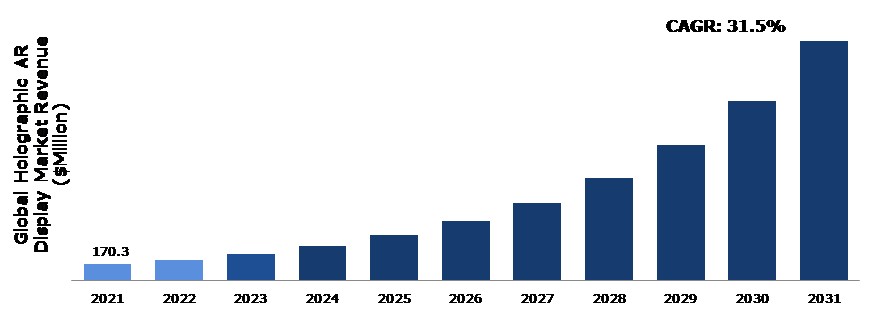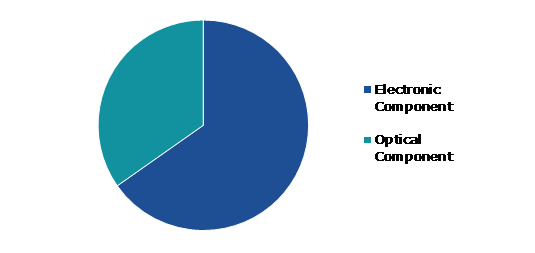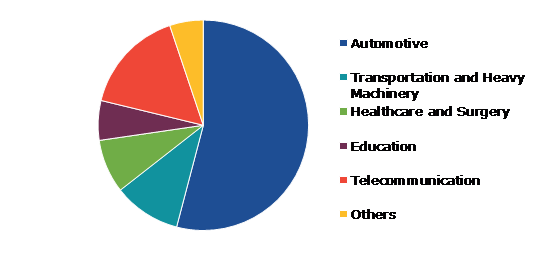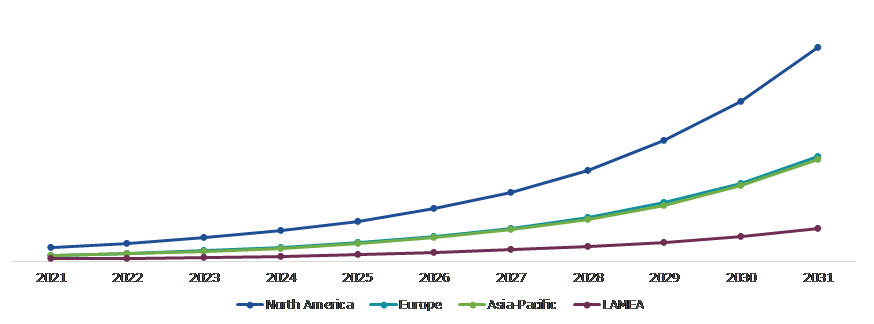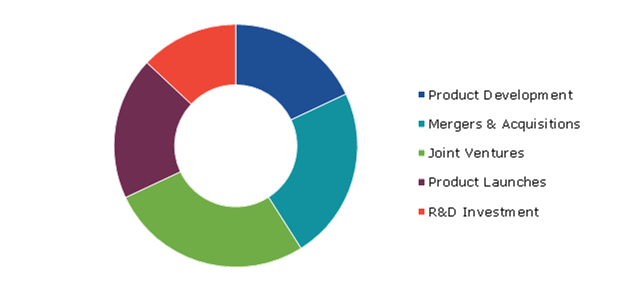Holographic AR Display Market Report
RA08604
Holographic AR Display Market by Component (Electronic Component and Optical Component (Diffractive Optical Element (DOE) and Holographic Optical Element (HOE))), Application (Automotive, Transportation and Heavy Machinery, Infrastructure, Healthcare and Surgery, Education, Telecommunication, and Others, and Regional Analysis (North America, Europe, Asia-Pacific, and LAMEA): Global Opportunity Analysis and Industry Forecast, 2022–2031
Global Holographic AR Display Market Analysis
The Global Holographic AR Display Market Size was $170.3 million in 2021 and is predicted to grow with a CAGR of 31.5%, by generating a revenue of $2,586.4 million by 2031.
Global Holographic AR Display Market Synopsis
The significant growth in the holographic AR display market share is primarily attributed to the rise in the adoption of holographic displays in automotive applications. Holographic AR displays offer an excellent projection system field of view compared to conventional head-up displays (HUDs). Also, they can be customized for any car model including commercial vehicles, trucks, economic cars, and self-driving cars. Holographic AR displays in vehicles increase road safety and in-vehicle experience by offering passengers as well as drivers various essential information including routes, ADAS info, traffic warning, speed limit, stoplight, pedestrian alerts, and others. The integration of AR technology into holographic displays has great potential for the future of connected vehicles.
The high cost of holographic AR displays is projected to hinder the market growth during the forecast period. Holographic AR display is an emerging technology, hence, there is less awareness in developing countries. The holographic AR display has improved dramatically in recent years, but there are still limitations on power sources and materials. This, in turn, is expected to hinder the holographic AR display market expansion. Apart from the automotive sector, holographic AR displays have great potential in other sectors including education, telecommunication, infrastructure, construction, and healthcare. AR integrates digital information with the real physical world using sensors and cameras as well as displays and efficiently transform the physical world with holographic images. With the continued advancement in holographic displays, they are anticipated to be used more in dentistry, medicine, and education in health sciences. Holographic AR displays represent an excellent opportunity to enhance the education process during dental studies. The utilization of holographic AR displays in the healthcare sector is a relatively new technique. Hence its widespread acceptance and utilization may take a few more years. All these factors are anticipated to create several growth opportunities for the key players operating in the holographic AR display market during the forecast period.
According to regional analysis, the North America holographic AR Display market accounted for the highest market share in 2021 and is projected to maintain its dominance during the forecast period, owing to continued R&D in AR and holographic display technology and the presence of major market players.
Holographic AR Display Market Overview
A holographic display uses light diffraction phenomena to form a virtual 3D image. By utilizing the power of neuromarketing, the holographic display helps brands to create an immersive visual experience. A holographic display works without the aid of any support equipment and produces digital content through glass with a special coating. Continued R&D activities are ongoing in holographic AR display technology and potential challenges such as high cost are expected to be solved in the upcoming years.
COVID-19 Impact on Holographic AR Display Market
The COVID-19 outbreak has adversely affected the holographic AR display market growth. Strict lockdown measures all over the globe and business operations slowdowns restricted the manufacturing of displays. The first two quarters of 2020 witnessed the shutdown of several manufacturing plants due to labor shortages. Holographic AR displays generally have high demands from the automotive sector. However, the automotive sector was among those that experienced the most substantial impacts. The drastic drop in vehicle sales led to losses in revenue and disruption in cash flow. This, in turn, impacted the holographic AR display market growth.
In the last few years, the use of cutting-edge technologies such as holographic AR displays for advertising and branding purposes increased in the professional media markets. Brands often utilize holographic displays for advertising to showcase their products in a 3D view. Holographic AR display makes a significant visual effect in the eyes of the consumers. However, the coronavirus pandemic dropped the advertising budgets of several brands all over the world. As consumers remained indoors due to lockdown and social distancing norms, brands mostly connected with consumers through online channels such as social media platforms. Due to all these factors, the demand for holographic displays reduced drastically during the pandemic.
The Surge in the Adoption of Holographic AR Displays in the Automotive Sector is anticipated to drive the Market Growth
Customers are increasingly inclined toward safety and an advanced in-car experience, owing to which there is a significant surge in the adoption of advanced technologies such as holographic AR displays in vehicles. Holographic displays flawlessly offer visual information and vehicle data to the driver within the limit of the driver's judgment. These displays allow the driver to focus only on the road to attain road information. Due to all these factors, the adoption of holographic AR displays is anticipated to accelerate in the upcoming years. In addition, the surge in customer expenditure on premium car services for comfort and safety is expected to further supplement the demand for holographic AR displays in the automotive sector.
To know more about global holographic AR display market drivers, get in touch with our analysts here.
High Cost along with Less Awareness About Holographic Technology is Anticipated to Restrain Holographic AR Display Market Growth
Despite the wide range of applications of holographic technology in numerous industries, its drawbacks such as its high price and less awareness are expected to hinder the market growth. Holographic displays are largely equipped only in the luxury cars segment due to their high price. In addition, the high cost of producing holographic display devices is a major cause of concern since it restricts new vendors from entering the market and, as a result, slows the expansion of the holographic display market. These factors are also anticipated to be a limitation to the holographic AR display market size growth during the forecast period.
Wider applicability of holographic AR displays in numerous industries including Infrastructure, Education, Telecommunication, and Healthcare to Offer Ample Growth Opportunities
Holographic AR displays have a promising future in numerous industries including infrastructure, education, telecommunication, healthcare, and others. Holographic AR display offers heavy machinery operators a comprehensive view of their surroundings, thus, avoiding distractions and reducing accidents. In medical applications, holographic displays can be used for X-rays and endoscopies. In recent times, there has been a significant surge in the use of holographic displays for advertising purposes. This technology can be used in digital signs, billboards, point-of-sale terminals, and others. The increase in the adoption of holographic AR displays in all of these sectors is expected to offer excellent growth opportunities for the major market players during the forecast period.
To know more about global holographic AR display market opportunities, get in touch with our analysts here.
Global Holographic AR Display Market, by Component
Based on component, the market is further divided into electronic component and optical component. Among these, the electronic component sub-segment held the largest market share in 2021 and is anticipated to witness the fastest CAGR during the forecast period.
Global Holographic AR Display Market Size, by Component, 2021
Source: Research Dive Analysis
The electronic component sub-segment dominated the global holographic AR display market in 2021 and is anticipated to witness the fastest CAGR during the forecast period. Holography and digital computational technologies were fundamentally merged to create the new technical field of electronic component holography. Holography displays use optical wavefronts to capture and replicate 3-D pictures. The captured interference pattern modifies an illumination beam in order to create an image. The wavefront that was scattered from the object scene is diffracted by the modulated light, and it is then recreated into three components. Optical wavefront reconstruction gives the appearance that the image is tangible and present.
Global Holographic AR Display Market, by Application
Based on application, the global holographic AR display market has been divided into automotive, transportation and heavy machinery, infrastructure, healthcare and surgery, education, telecommunication, and others. Among these, the automotive sub-segment is anticipated to show the fastest CAGR during the forecast period.
Global Holographic AR Display Market Share, by Application, 2021
Source: Research Dive Analysis
The automotive sub-segment dominated the market in 2021 and is expected to have the fastest growth during the forecast period. According to World Health Organization, approximately 1.3 million people die each year on account of road traffic crashes. Human negligence is a main contributing factor in most of these crashes. Drivers are often exposed to a large amount of audio as well as visual information while driving a car. Moreover, many drivers operate smartphones while driving irrespective of strict warnings by road authorities. Numerous countries worldwide have passed legislation to prohibit the use of digital gadgets while driving a vehicle. The integration of holographic AR displays in the cars helps to lower the sight shift of the driver from the road. In addition, holographic AR displays improve driver comfort along with an increase in road safety.
Global Holographic AR Display Market, Regional Insights
The holographic AR display market was investigated across North America, Europe, Asia-Pacific, and LAMEA.
Global Holographic AR Display Market Size & Forecast, by Region, 2021-2031 (USD Million)
Source: Research Dive Analysis
North America Dominated the Holographic AR Display Market in 2021
The North America region dominated the global holographic AR display market in 2021. Major aspects attributed to the significant growth of the holographic AR display market across North America are the presence of major players, increase in R&D activities, increase in disposable income, and increase in demand for luxury vehicles. Another significant factor that is propelling the growth of the market in this region is the surge in the adoption of holographic AR display systems by automotive companies to offer an immersive experience to their consumers as well as increase the safety of drivers.
Global Holographic AR Display Market Competitive Scenario
Joint ventures, investment, merger & acquisition, product development, and technological development are the common strategies followed by major holographic AR display market players. For instance, in 2021, WayRay AG and Karma Automotive announced a collaboration to integrate AR Head-Up Display (HUD) technology in a future Karma vehicle.
Some of the leading players in the holographic AR display market are WayRay AG., Continental AG, Visteon Corporation, Sygic, DigiLens Inc., Indiegogo, Inc., Futurus Group, and Avegant Corp.
| Aspect | Particulars |
| Historical Market Estimations | 2020 |
| Base Year for Market Estimation | 2021 |
| Forecast timeline for Market Projection | 2022-2031 |
| Geographical Scope | North America, Europe, Asia-Pacific, and LAMEA |
| Segmentation by Component
|
|
| Segmentation by Application |
|
| Key Companies Profiled |
|
Q1. What is the size of the holographic AR display market?
A. The global holographic AR display market size was over $170.3 million in 2021 ¬¬and is anticipated to reach $2,586.4 million by 2031.
Q2. Which are the leading companies in the holographic AR display market?
A. WayRay AG., Continental AG, and Visteon Corporation are some of the key players in the global holographic AR display market.
Q3. Which region possesses greater investment opportunities in the future?
A. Asia-Pacific possesses great investment opportunities for investors in the coming years.
Q4. What is the growth rate of the Asia-Pacific market?
A. The Asia-Pacific holographic AR display market is anticipated to grow at 32.9% CAGR during the forecast period.
Q5. What are the strategies opted by the leading players in this market?
A. Product innovations, business expansions, and technological advancements are the key strategies opted by the operating companies in this market.
Q6. Which companies are investing more on R&D practices?
A. Indiegogo, Inc., Futurus Group, and Avegant Corp. are investing more on R&D activities for developing new products and technologies.
1.Research Methodology
1.1.Desk Research
1.2.Real time insights and validation
1.3.Forecast model
1.4.Assumptions and forecast parameters
1.5.Market size estimation
1.5.1.Top-down approach
1.5.2.Bottom-up approach
2.Report Scope
2.1.Market definition
2.2.Key objectives of the study
2.3.Report overview
2.4.Market segmentation
2.5.Overview of the impact of COVID-19 on Global Holographic AR Display market
3.Executive Summary
4.Market Overview
4.1.Introduction
4.2.Growth impact forces
4.2.1.Drivers
4.2.2.Restraints
4.2.3.Opportunities
4.3.Market value chain analysis
4.3.1.List of raw material suppliers
4.3.2.List of manufacturers
4.3.3.List of distributors
4.4.Innovation & sustainability matrices
4.4.1.Technology matrix
4.4.2.Regulatory matrix
4.5.Porter’s five forces analysis
4.5.1.Bargaining power of suppliers
4.5.2.Bargaining power of consumers
4.5.3.Threat of substitutes
4.5.4.Threat of new entrants
4.5.5.Competitive rivalry intensity
4.6.PESTLE analysis
4.6.1.Political
4.6.2.Economical
4.6.3.Social
4.6.4.Technological
4.6.5.Environmental
4.7.Impact of COVID-19 on Holographic AR Display market
4.7.1.Pre-covid market scenario
4.7.2.Post-covid market scenario
5.Holographic AR Display Market Analysis, by Component
5.1.Overview
5.2.Electronic Component
5.2.1.Definition, key trends, growth factors, and opportunities
5.2.2.Market size analysis, by region
5.2.3.Market share analysis, by country
5.3.Optical Component
5.3.1.Diffractive Optical Element (DOE)
5.3.1.1.Definition, key trends, growth factors, and opportunities
5.3.1.2.Market size analysis, by region
5.3.1.3.Market share analysis, by country
5.3.2.Holographic Optical Element (HOE)
5.3.2.1.Definition, key trends, growth factors, and opportunities
5.3.2.2.Market size analysis, by region
5.3.2.3.Market share analysis, by country
5.4.Research Dive Exclusive Insights
5.4.1.Market attractiveness
5.4.2.Competition heatmap
6.Holographic AR Display Market Analysis, by Application
6.1.Automotive
6.1.1.Definition, key trends, growth factors, and opportunities
6.1.2.Market size analysis, by region
6.1.3.Market share analysis, by country
6.2.Transportation and Heavy Machinery
6.2.1.Definition, key trends, growth factors, and opportunities
6.2.2.Market size analysis, by region
6.2.3.Market share analysis, by country
6.3.Infrastructure
6.3.1.Definition, key trends, growth factors, and opportunities
6.3.2.Market size analysis, by region
6.3.3.Market share analysis, by country
6.4.Healthcare and Surgery
6.4.1.Definition, key trends, growth factors, and opportunities
6.4.2.Market size analysis, by region
6.4.3.Market share analysis, by country
6.5.Education
6.5.1.Definition, key trends, growth factors, and opportunities
6.5.2.Market size analysis, by region
6.5.3.Market share analysis, by country
6.6.Telecommunication
6.6.1.Definition, key trends, growth factors, and opportunities
6.6.2.Market size analysis, by region
6.6.3.Market share analysis, by country
6.7.Others
6.7.1.Definition, key trends, growth factors, and opportunities
6.7.2.Market size analysis, by region
6.7.3.Market share analysis, by country
6.8.Research Dive Exclusive Insights
6.8.1.Market attractiveness
6.8.2.Competition heatmap
7.Holographic AR Display Market, by Region
7.1.North America
7.1.1.U.S.
7.1.1.1.Market size analysis, by Component
7.1.1.2.Market size analysis, by Application
7.1.2.Canada
7.1.2.1.Market size analysis, by Component
7.1.2.2.Market size analysis, by Application
7.1.3.Mexico
7.1.3.1.Market size analysis, by Component
7.1.3.2.Market size analysis, by Application
7.1.4.Research Dive Exclusive Insights
7.1.4.1.Market attractiveness
7.1.4.2.Competition heatmap
7.2.Europe
7.2.1.Germany
7.2.1.1.Market size analysis, by Component
7.2.1.2.Market size analysis, by Application
7.2.2.UK
7.2.2.1.Market size analysis, by Component
7.2.2.2.Market size analysis, by Application
7.2.3.France
7.2.3.1.Market size analysis, by Component
7.2.3.2.Market size analysis, by Application
7.2.4.Switzerland
7.2.4.1.Market size analysis, by Component
7.2.4.2.Market size analysis, by Application
7.2.5.Italy
7.2.5.1.Market size analysis, by Component
7.2.5.2.Market size analysis, by Application
7.2.6.Russia
7.2.6.1.Market size analysis, by Component
7.2.6.2.Market size analysis, by Application
7.2.7.Rest of Europe
7.2.7.1.Market size analysis, by Component
7.2.7.2.Market size analysis, by Application
7.2.8.Research Dive Exclusive Insights
7.2.8.1.Market attractiveness
7.2.8.2.Competition heatmap
7.3.Asia-Pacific
7.3.1.China
7.3.1.1.Market size analysis, by Component
7.3.1.2.Market size analysis, by Application
7.3.2.Japan
7.3.2.1.Market size analysis, by Component
7.3.2.2.Market size analysis, by Application
7.3.3.India
7.3.3.1.Market size analysis, by Component
7.3.3.2.Market size analysis, by Application
7.3.4.Australia
7.3.4.1.Market size analysis, by Component
7.3.4.2.Market size analysis, by Application
7.3.5.South Korea
7.3.5.1.Market size analysis, by Component
7.3.5.2.Market size analysis, by Application
7.3.6.Rest of Asia-Pacific
7.3.6.1.Market size analysis, by Component
7.3.6.2.Market size analysis, by Application
7.3.7.Research Dive Exclusive Insights
7.3.7.1.Market attractiveness
7.3.7.2.Competition heatmap
7.4.LAMEA
7.4.1.Brazil
7.4.1.1.Market size analysis, by Component
7.4.1.2.Market size analysis, by Application
7.4.2.Saudi Arabia
7.4.2.1.Market size analysis, by Component
7.4.2.2.Market size analysis, by Application
7.4.3.UAE
7.4.3.1.Market size analysis, by Component
7.4.3.2.Market size analysis, by Application
7.4.4.South Africa
7.4.4.1.Market size analysis, by Component
7.4.4.2.Market size analysis, by Application
7.4.5.Rest of LAMEA
7.4.5.1.Market size analysis, by Component
7.4.5.2.Market size analysis, by Application
7.4.6.Research Dive Exclusive Insights
7.4.6.1.Market attractiveness
7.4.6.2.Competition heatmap
8.Competitive Landscape
8.1.Top winning strategies, 2021
8.1.1.By strategy
8.1.2.By year
8.2.Strategic overview
8.3.Market share analysis, 2021
9.Company Profiles
9.1.WayRay AG
9.1.1.Overview
9.1.2.Business segments
9.1.3.Product portfolio
9.1.4.Financial performance
9.1.5.Recent developments
9.1.6.SWOT analysis
9.2.Continental AG
9.2.1.Overview
9.2.2.Business segments
9.2.3.Product portfolio
9.2.4.Financial performance
9.2.5.Recent developments
9.2.6.SWOT analysis
9.3.Visteon Corporation
9.3.1.Overview
9.3.2.Business segments
9.3.3.Product portfolio
9.3.4.Financial performance
9.3.5.Recent developments
9.3.6.SWOT analysis
9.4.Sygic
9.4.1.Overview
9.4.2.Business segments
9.4.3.Product portfolio
9.4.4.Financial performance
9.4.5.Recent developments
9.4.6.SWOT analysis
9.5.DigiLens Inc.
9.5.1.Overview
9.5.2.Business segments
9.5.3.Product portfolio
9.5.4.Financial performance
9.5.5.Recent developments
9.5.6.SWOT analysis
9.6.Indiegogo, Inc.
9.6.1.Overview
9.6.2.Business segments
9.6.3.Product portfolio
9.6.4.Financial performance
9.6.5.Recent developments
9.6.6.SWOT analysis
9.7.Futurus Group
9.7.1.Overview
9.7.2.Business segments
9.7.3.Product portfolio
9.7.4.Financial performance
9.7.5.Recent developments
9.7.6.SWOT analysis
9.8.Avegant Corp.
9.8.1.Overview
9.8.2.Business segments
9.8.3.Product portfolio
9.8.4.Financial performance
9.8.5.Recent developments
9.8.6.SWOT analysis
Augmented reality (AR) provides additional information to the user by placing a virtual image in the real world. There are numerous ways to implement AR. Holographic display is one of the probable methods of using AR, owing to its flawless 3D demonstration. Holographic displays can provide in-depth information to the virtual 3D object. An AR system with a real 3D scene can be created by combining holographic displays. Holographic displays promise to offer a significantly improved AR experience in a variety of useful applications.
A holographic display offers three-dimensional images on a screen or in space by using coherent light produced by a laser. It is widely utilized in virtual reality (VR) and augmented reality (AR) applications. Holographic displays that incorporate laser plasma technology may create images out of thin air without the use of a screen or other external refraction medium, creating a hanging light that astounds viewers and leaves a lasting impression. Holographic displays are the most popular because they can transfer recorded image data via an electromagnetic resonator, giving them a particular edge in security-related applications. The global holographic AR display market is expanding at a rapid pace due to the rise of entertainment displays in vehicles.
Newest Insights in the Holographic AR Display Market
The increasing applications of holographic displays in the automotive, healthcare, education, media and entertainment, military mapping, and residential sectors have boosted the demand for holographic displays. As per a report by Research Dive, the global holographic AR display market is expected to surpass a revenue of $2,586.4 million in the 2022–2031 timeframe. The North America holographic AR display market is expected to perceive foremost and dominant growth in the years to come. This is because the region has a gigantic demand for holographic AR display systems from the automotive industry to provide a more immersive experience to their customers and boost driving safety in the region.
How are Market Players Responding to the Rising Demand for Holographic AR Display?
Market players are massively investing in innovative research and inventions to cater for the rising demand for holographic displays for events, promotions, and advertising. Some of the foremost players in the holographic AR display market are Continental AG, WayRay AG., Sygic, DigiLens Inc., Visteon Corporation, Indiegogo, Inc., Avegant Corp., Futurus Group, and others. These players are focused on planning and devising tactics such as mergers and acquisitions, collaborations, novel advances, and partnerships to reach a notable position in the global market. For instance:
- In April 2022, HYPERVSN, a British company that offers 3D holographic solutions, launched HYPERVSN SmartV, a next-generation platform that gives customers smart 3D graphics, higher brightness, and greater resolution, and can also be used as part of any traditional digital signage installation.
- In June 2022, Looking Glass Factory, a group of engineers, innovators, and artists dedicated to developing a hologram-powered future for 3D creators everywhere, launched a revolutionary 65-inch 8K display, the largest, highest resolution holographic display ever made. The new display is a unique product, which is 50 times larger than any other group-viewable holographic display that has ever been commercially available and 5 times larger than any other 3D holographic display that has ever been tested in a lab by another company.
- In January 2023, ThirdEye, a leader in artificial intelligence and augmented reality solutions, announced the release of a completely integrated hardware and software healthcare package that offers solutions for AR holographic displays, AR telehealth, artificial intelligence remote surgery, vision impairment, Alzheimer's assistance, and thermal display.
COVID-19 Impact on the Global Holographic AR Display Market
The unpredicted rise of the coronavirus pandemic in 2020 adversely impacted the global holographic AR display market. During the pandemic period, implementation of strict lockdown precautions and slowdown business of operations across the world greatly hampered display manufacturing. Several manufacturing plants were forced to close in the first two quarters of 2020 owing to labor shortages. Holographic AR displays are mainly in great demand in the automotive industry. However, the automotive industry was among those that suffered the most due to the pandemic crisis. The sharp decline in vehicle sales resulted in revenue losses and disruptions to cash flow. This, in turn, impacted the growth of the holographic AR display market. However, the market is expected to recover soon in the post-pandemic period.
Personalize this research
- Triangulate with your own data
- Request your format and definition
- Get a deeper dive on a specific application, geography, customer or competitor
- + 1-888-961-4454 Toll - Free
- support@researchdive.com

